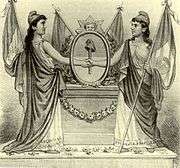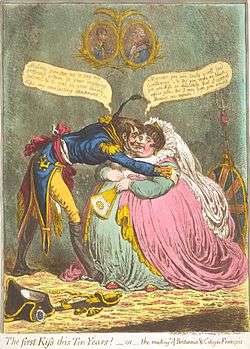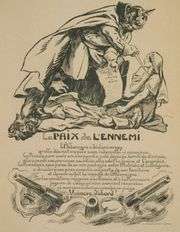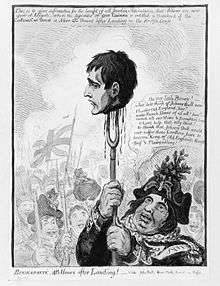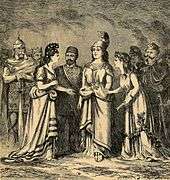| Country |
Image |
Personification |
|---|
 Albania Albania |
 |
Mother Albania (Nëna Shqipëria) |
 Angola Angola |
 |
Giant sable antelope (palanca-negra) |
 Argentina Argentina |
 |
Effigy of the Republic/Liberty/Progress/Fatherland, Gaucho, Martín Fierro |
 Armenia Armenia |
 |
Mother Armenia (Mayr Hayastan; lit. "Mother Hayastan") |
 Australia Australia |
 |
Little Boy from Manly |
 Austria Austria |
|
Austria (personification) and the federal eagle |
 Bangladesh Bangladesh |
|
Mother Bengal (also known as Bangla Maa); Bengal tiger.[2]
Joy Bangla (Bengali: জয় বাংলা; meaning "Victory to Bengal") was the slogan and war cry of the Mukti Bahini that fought for the independence of Bangladesh during the Bangladesh Liberation War in 1971.[3] |
.svg.png) Belgium Belgium |
 |
La Belgique or Belgica. The country is also commonly represented by a lion, historically known as Leo Belgicus. |
 Brazil Brazil |
 |
Efígie da República; the Bandeirante (only in São Paulo State); the Candango (in Brasília); the Gaúcho (in Rio Grande do Sul) |
 Belarus Belarus |
|
Rus |
 Bulgaria Bulgaria |
 |
Mother Bulgaria |
 Cambodia Cambodia |
|
Preah Thong and Neang Neak |
 Canada Canada |
 |
Mountie, Johnny Canuck, Le Vieux de '37 (French Canada), Adam Dollard des Ormeaux (used during the two World Wars as a military example), Mother Canada (at the Vimy Memorial) |
 Chile Chile |
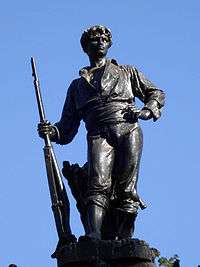 |
El Roto, El Huaso, La Carmela, Doña Juanita (an average Chilean woman from the countryside), Moya (a common surname used as N.N.) |
 China China |
 |
Chinese dragon, Chinese phoenix, panda, etc. |
 Czech Republic Czech Republic |
 |
Čechie, Czech Vašek, double-tailed Czech lion, Svejk. |
 Denmark Denmark |
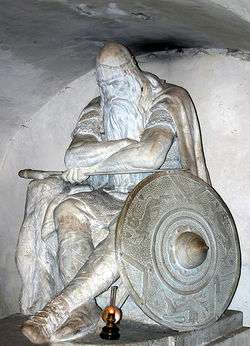 |
Holger Danske |
 Dominican Republic Dominican Republic |
|
Yania Tierra |
 Egypt Egypt |
 |
Mother of the World (Om El Donia) |
 El Salvador El Salvador |
 |
Monumento al Divino Salvador del Mundo |
 Europe Europe |
.jpg) |
Europa or Europa regina |
 Finland Finland |
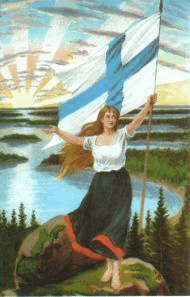 |
Finnish Maiden (Suomi-neito) |
 France France |
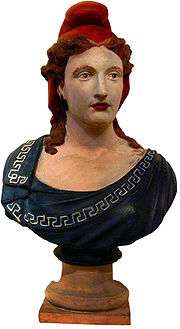 |
Marianne, Gallic rooster |
 Georgia Georgia |
 |
Georgia: Saint George, "Mother of a Georgian" (Kartvlis Deda) |
 Germany Germany |
.jpg) |
Germany: Germania, Arminius (Hermann der Cherusker), Deutscher Michel
Bavaria: Bavaria, Berlin: Berolina, Brunswick: Brunonia, Franconia: Franconia, Hamburg: Hammonia, Prussia: Borussia, Palatinate: Palatia, Saxony: Saxonia |
 Greece Greece |
 |
Athena, "Greece" by Delacroix |
 Haiti Haiti |
 |
Ezili Dantor |
 Iceland Iceland |
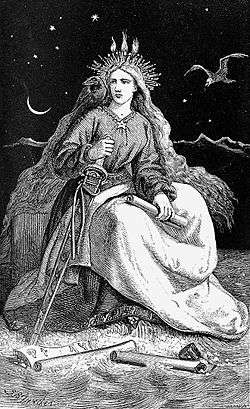 |
The Lady of the Mountains (Fjallkonan) |
 India India |
 |
Bharat Mata ("Mother India"), earlier the goddess Durga. Also the tiger or the Indian elephant is used to personify the nation. But strictly speaking of national personification, the figure of Bharat Mata as a goddess, wearing a white or saffron sari, holding the national flag, and having a lion as her vahana is the most widely popular personification. The battle cry, "Bharat Mata ki Jai" (Victory for Mother India) is used by the Indian Army and is one of the most popular patriotic slogans used in India. |
 Indonesia Indonesia |
 |
Ibu Pertiwi |
 Iran Iran |
 |
Cyrus the Great |
 Ireland Ireland |
 |
Ériu, Banba, Fódla, Kathleen Ni Houlihan, Hibernia, Scotia,[4] Granuaile, The Old Woman of Beare [5] |
 Israel Israel |
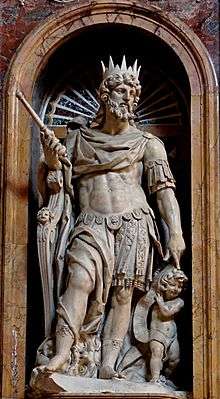 |
King David, Srulik |
 Italy Italy |
 |
Italia Turrita |
 Japan Japan |
 |
Amaterasu Omikami |
 Korea Korea |
|
Dangun |
 Macedonia Macedonia |
|
Mother Macedonia[6][7] |
 Malaysia Malaysia |
 |
Hang Tuah,Harimau Malaya |
 Malta Malta |
 |
Melita |
 Mexico Mexico |
 |
Alegoría de la Patria Mexicana (es), Our Lady of Guadalupe, La China Poblana |
 Mongolia Mongolia |
 |
Genghis Khan |
 Netherlands Netherlands |
 |
de Nederlandse Maagd` ("The Dutch Maiden"), De Leeuw van Oranje, Hans Brinker (outside the Netherlands), (Zeeland: Zeeuws Meisje) |
 New England New England |
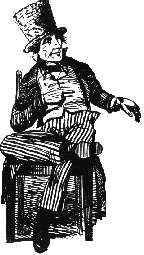 |
Brother Jonathan, Puritan, pine tree. |
 New Zealand New Zealand |
 |
Kiwi, Zealandia, southern man (for the South Island) |
 Norway Norway |
 |
Mother Norway, Ola Nordmann, Kari Nordmann, hist. Nór |
 Pakistan Pakistan |
|
Mumlikat-e-Khudadad ('God-given State') |
 Palestine Palestine |
|
Handala |
 Peru Peru |
|
The chalán, La Madre Patria |
 Philippines Philippines |
|
Juan dela Cruz, Ináng Bayan, Luzviminda(Luzon, Visayas, Mindanao), Filipinas, Philippine eagle |
 Poland Poland |
 |
Polonia, Lech, |
 Portugal Portugal |
 |
Zé Povinho, Eu nacional (National Self), Lusitania (Ancient Roman Province consisting of what is mainly Portugal now), Republic effigy, Rooster of Barcelos, Guardian Angel of Portugal |
 Romania Romania |
 |
România |
 Russia Russia |
 |
Mother Russia/Mother Motherland, Rus, Russian Bear |
 Scotland Scotland |
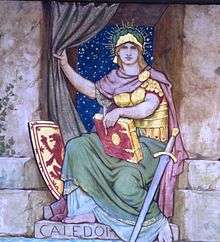 |
Caledonia, Jock Tamson, Scotia, Cailleach |
 Serbia Serbia |
 |
Mother Serbia, Kosovo Maiden, |
 Singapore Singapore |
 |
The Merlion |
 Slovakia Slovakia |
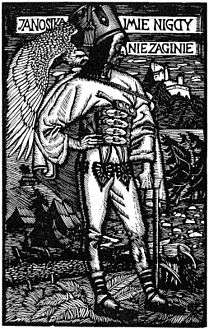 |
Jánošík |
 Slovenia Slovenia |
|
Kranjski Janez ("John from Carniola", an average man from Slovenia's central region), Peter Klepec |
 Spain Spain |
_02b.jpg) |
Hispania |
 Sweden Sweden |
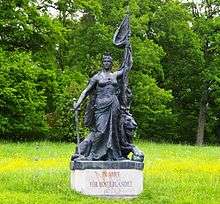 |
Mother Svea |
 Switzerland Switzerland |
.jpg) |
Helvetia |
 Ukraine Ukraine |
 |
Cossack Mamay, Rus |
 United Kingdom United Kingdom |
 |
Britannia, John Bull, lion, Bulldog |
 United States United States |
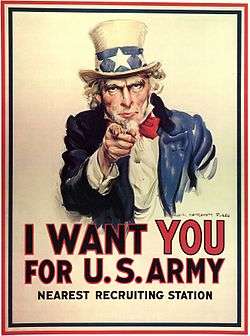 |
Uncle Sam (government personification), Statue of Liberty as Lady Liberty, Columbia, Johnny Rebel (The South, obsolete), Billy Yank (The North, obsolete), Brother Jonathan, bald eagle |
 Wales Wales |
 |
Dame Wales, Deffroad Cymru, the Awakening of Wales, Welsh Dragon |
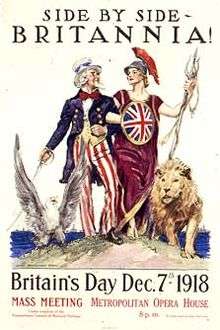














.jpg)



.jpg)






















_02b.jpg)
.jpg)





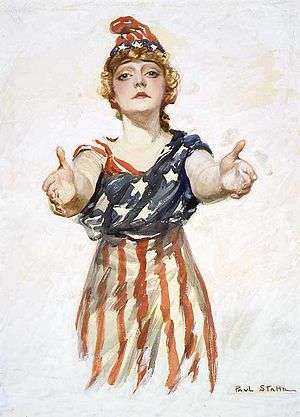


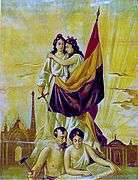


.jpg)





